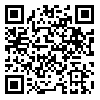2- Department of Environmental Health Engineering, School of Public Health, Tehran University of Medical Sciences, Tehran, Iran ,
Background and Objectives: Considering the complexity, cost, and time-consuming techniques of detecting Cryptosporidium oocysts and Giardia cysts, B. subtilits spores have been introduced as microbial indicators of these pathogens to evaluate the efficacy of disinfection studies. The present study was aimed to investigate the feasibility of B. subtilis spores inactivation using hydrogen peroxide combined with copper and silver ions. A new glutaraldehyde based compound used for surface disinfection was also tested.
Materials and Methods: In order to sporulation, vegetative bacteria were allowed to grow on a medium with insufficient nutrients, and after 5 days incubation at 37˚C, spores were washed and purified. Spore suspension was used to prepare synthetic water. Disinfection efficiency was reported as logarithmic decrease of initial spore count.
Results: This research found that none of the disinfection compounds was able to spore inactivation in low initial concentration. The highest spore reduction efficiency was related to HP/Cu+2 with 1.48 log inactivation, and HP/Ag+ compound placed in the second rank with 1.03 log reduction. Maximum spore reduction of 0.6 log was achieved when glutaraldehyde based disinfectant was used in disinfection process.
Conclusion: According to the results, it can be concluded that spores are very resistant even to combination of disinfectants. Spore reduction potential of the studied compounds was as follows: HP/Cu+2> HP/Ag+> glutaraldehyde based compound.
Received: 2015/11/4 | Accepted: 2016/01/11 | Published: 2016/03/2
| Rights and Permissions | |
 |
This work is licensed under a Creative Commons Attribution-NonCommercial 4.0 International License. |


